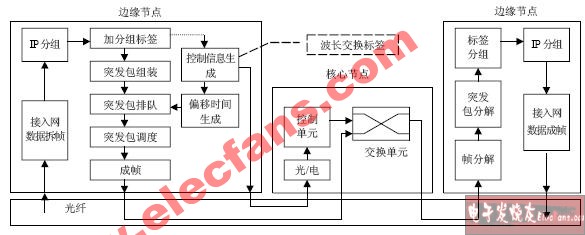Principle and network structure of optical burst switching based on GMPLS
GMPLS-based OBS has the basic characteristics of OBS, such as variable-length data forwarding units (burst packets); control information (control packets) and burst packets are transmitted at separate wavelengths; at each node on the transmission path, control packets Converted to electrical signals for processing, and burst packets are transparently passed in the form of optical signals. At the same time, GMPLS-based OBS absorbs the idea of ​​GMPLS, and adds labels that can be managed uniformly in the IP layer and the optical layer, which simplifies the network structure and makes burst packet transmission faster. In order to avoid the need of core nodes for optical caching, some OBS control protocols such as (Tell And Go, TAG) and (Just Enough TIme, JET) are still adopted.
Figures 1 and 2 are the structure diagram and layered structure diagram of OBS backbone network based on GMPLS, respectively.
In Figure 1, the edge node is not only a part of the IP network, but also needs to process the IP data sent by the access network, and is connected to the optical network composed of core nodes, and generates burst packets transmitted in the optical network. The IP and optical networks in the GMPLS-based OBS network have unified signaling and protocols. For the control plane, the IP network and the optical network are completely equivalent and use a unified addressing mechanism (optical devices are regarded as IP addressable devices), the topology of the optical network is completely visible to the IP network. Both IP networks and optical networks use IP addresses. The IP layer can directly control the optical layer for routing and traffic, thereby unifying control, avoiding duplication, and simplifying the network structure.

Figure 1 The structure of the OBS backbone network based on GMPLS In Figure 2, the data of the access network enters the edge node [1], after deframing, analyzes the information of the IP packet, and then adds the forwarding equivalent determined by its destination address and priority, etc. Class (Forwarding Equivalence Class, FEC) is bound to the label. Once this label is added, the data transmission path is also determined by the pre-determined label forwarding path (Label Switch Path, LSP). At this time, the LSP is packet switching LSP. Then the data generates burst packets according to the LSP convergence and burst packet generation algorithm. After the burst packet is generated, first send the burst packet control information (Burst Head Packet, BHP). The BHP contains a wavelength-switched label, which corresponds to the LSP of the optical layer. After the BHP is sent out, the burst data packet takes the time to process the BHP on the entire LSP as the offset time. Since the edge source node is the starting point of the source routing and has a good understanding of the network topology, the offset can be easily determined when the LSP is established time. After the offset time is determined, the data can be sent out. GMPLS uses labels as the control information for optical switching, and the implementation of QoS can also be achieved by increasing the offset time. In addition, the recommended label in GMPLS can greatly reduce the offset time [2], so the setting of the offset time becomes Make it easier, and network resources can also be used more effectively. The BHP header is transmitted to the control unit of the core node via the control channel (after photoelectric conversion), the control unit turns on the corresponding optical switch according to the label information in the BHP, and the new label in the label forwarding table replaces the label in the original BHP to generate a new The BHP is transferred to the next core node (assuming that there is only one core node in Figure 2), and the data is directly passed by the optical path without processing in the core node. After the data arrives at the destination edge node, after frame decomposition and burst packet decomposition, a labeled IP packet is obtained. From the label, the edge node obtains the corresponding port of the access network where the destination node corresponds to the IP packet, and adds the data The frame header is sent from this port.

Figure 2 Layered structure of optical burst switching based on GMPLS
Research on Optical Burst Switching Based on GMPLS
1. Made of high-quality material, durable and reliable.
2. Unique design, fashionable appearance, a perfect gift to your child.
3. Long lifespan and low power consumption.
4. Eye protection: no flicker, no glare and soft lighting.
5. Energy-saving, environmental.
6. Office Desk Lamp Multi-angle lighting with rotatable and foldable lamp arm.
900-2000 Lumen LED Desk Lamp,High Lumen Desk Lamp
Shenzhen Superlight Technology Co., Ltd. , https://www.superlighttech.com